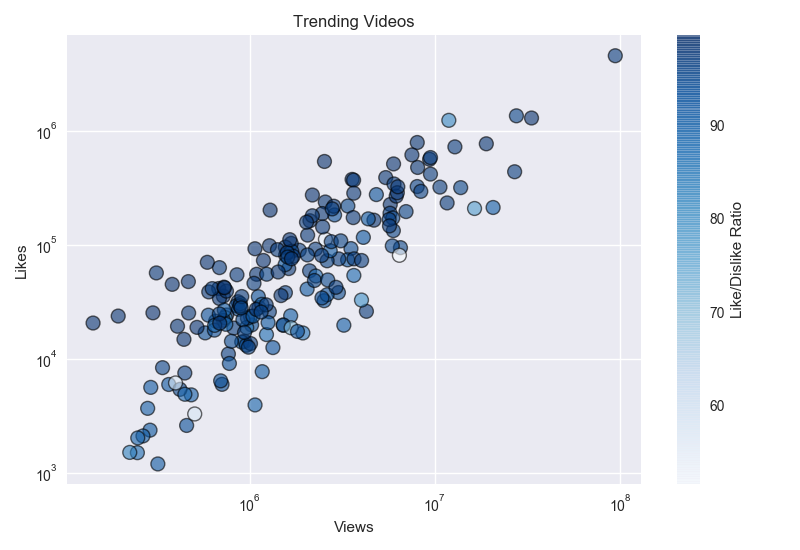


Python plot scatter how to#
Then, you learned how to change the size of markers based on another value. You first learned how to change the size of all markers.

Being able to modify the size of markers allows you to more effectively communicate the intent of your data. In this tutorial, you learned how to set the marker size of scatterplot points in Matplotlib. If you were to change this, then the relative sizes that you see would change as well. By default, Matplotlib uses a resulting of 100 DPI (meaning, per inch). However, as with everything else in Matplotlib there is significant logic behind it.Įach point is actually the pixel size, which varies by the resolution that you set for the figure itself. It may feel like we’ve been setting values arbitrarily. Understanding what the marker size represents simplifies a lot of the understanding behind it. Using a function to set the marker size of points in Matplotlib What is the Marker Size in Matplotlib? This data is shown by placing various data points. Plt.title('Changing Marker Sizes Based on Another Value - datagy.io') A scatter plot is a type of data visualization that shows the relationship between different variables. # Adding another variable to control size We’ll add another array of values that will control the size: # Controlling the size of markers with another variable Because the s= parameter also accepts an array of values, we can simply pass in that array. Let’s say we had another dimension to our data, we can use the values in that dimension to control the size. In this section, we’ll look at using another set of values to set the size of matplotlib scatterplot markers. A Scatter plot is a type of data visualization technique that shows the relationship between two numerical variables. Changing the Marker Size for Individual Points in Matplotlib Scatterplots Based on Other Data Pandas / Python FebruSpread the love Pandas DataFrame plot.scatter () is used to create a scatter plot by using dots to represent values of two different numeric variables. In order to get a marker that is, say, size 10, we need to pass in the square of that. The s parameter is defined as the marker size in points ** 2, meaning that the value passed in is squared. The coordinates of each point are defined by two dataframe columns and filled circles are used.

For further understanding, the pyplot module has a function called scatter(), among many. To understand what the s= parameter controls, we need to take a look at the documentation. Create a scatter plot with varying marker point size and color. scatter() function in matplotlib is used to create a scatter plot. Plt.title('Changing Marker Sizes for All Points - datagy.io')Ĭhanging the marker size for all markers in Matplotlib Let’s see how we can change the size for all markers using the s= parameter: # Changing the size for all markers in Matplotlib Passing in a list of values changes the size for each marker individually.To build a scatter plot, we require two sets of data where one set of arrays represents the x axis and the other set of arrays represents the y axis data. To represent a scatter plot, we will use the matplotlib library. The dots in the plot are the data values. Passing in a single value changes the size for all markers Scatter plot in Python is one type of a graph plotted by dots in it.These options determine what the size of the markers is: The two-dimensional graph with an axis that is. The parameter accepts either an integer or a list of values. The scatter plot can be defined as a type of plot that illustrates the data as a collection of points or dots. The size of points is based on the s= parameter. Matplotlib makes it simple to change the plot size for all points in a scatter plot. Changing the Marker Size for All Points in Matplotlib Scatterplots In the next section, you’ll learn how to change the marker size for all points in a Matplotlib scatterplot. In matplotlib, you can create a scatter plot using the pyplots scatter() function. Imscatter(x, y, image_path, zoom=0.1, ax=ax)ĭef imscatter(x, y, image, ax=None, zoom=1):Īb = AnnotationBbox(im, (x0, y0), xycoords='data', frameon=False)Īx.update_datalim(np.Creating a simple scatterplot in Matplotlib Scatter plots are great to visualize the data points in two dimensions. Here's an example of the second option: import numpy as npįrom matplotlib.offsetbox import OffsetImage, AnnotationBboxįrom matplotlib.cbook import get_sample_data Using imshow will tie the size of the image to the data coordinates of the plot. The scatter() function plots one dot for each observation. The annotation box approach will allow the image to stay at a constant size as you zoom in. With Pyplot, you can use the scatter() function to draw a scatter plot. The first way is the easiest to understand, but the second has a large advantage. Use an OffsetImage inside an AnnotationBbox.Plot the image using imshow with the extent kwarg set based on the location you want the image at.


 0 kommentar(er)
0 kommentar(er)
